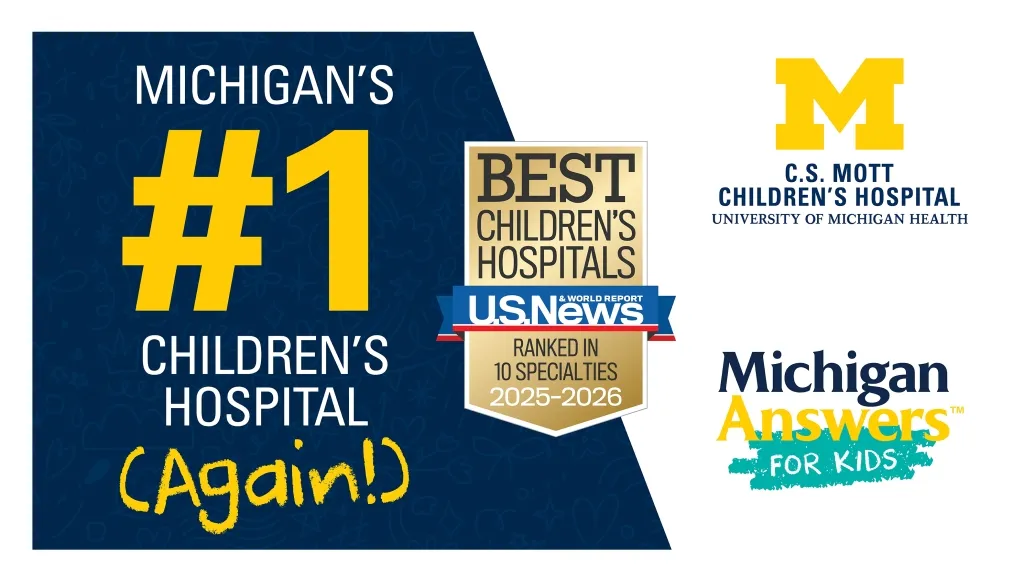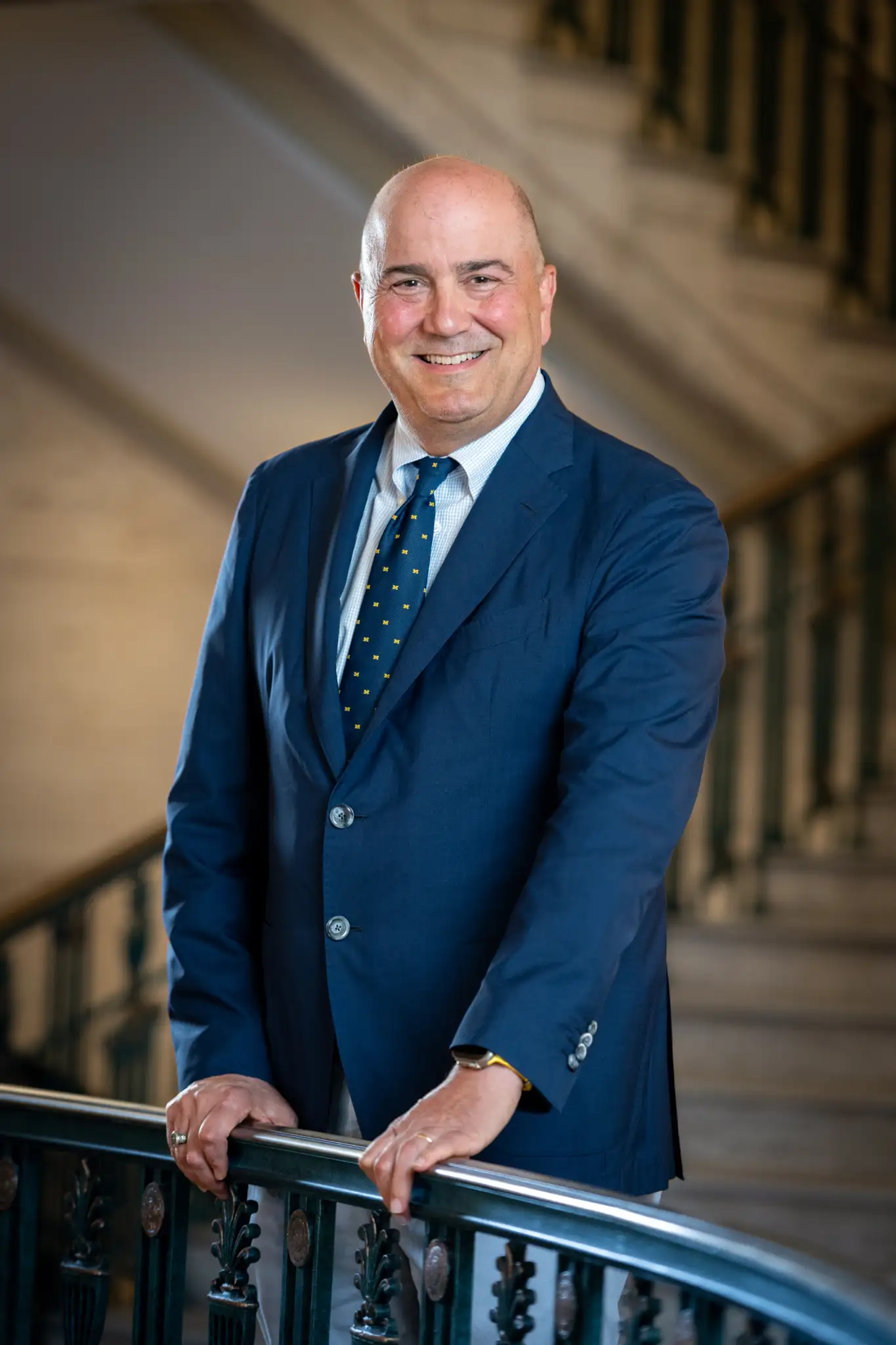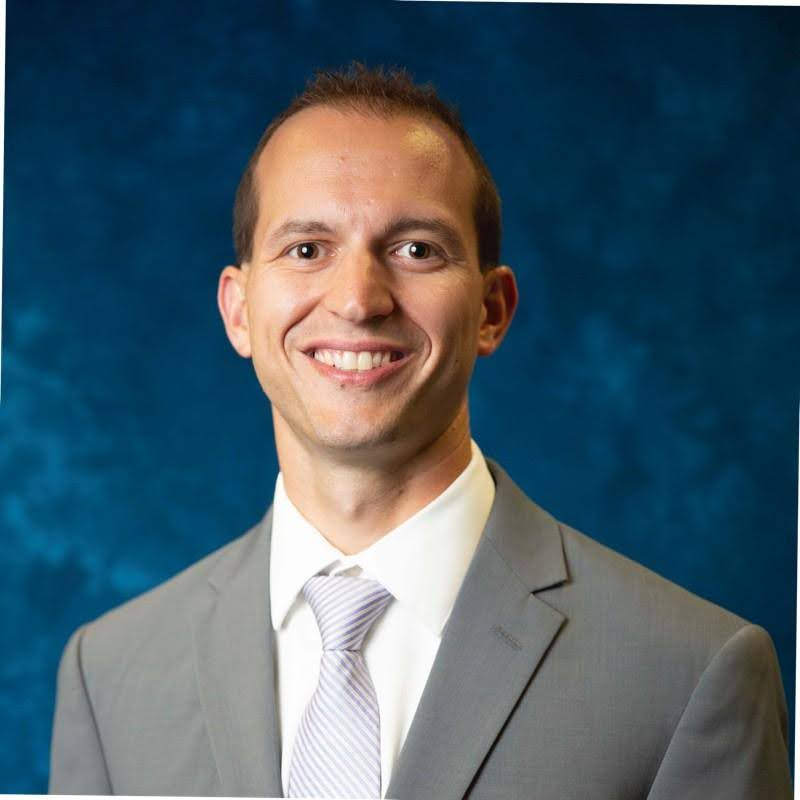Geoffrey Chatas, Executive Vice President and Chief Financial Officer
University of Michigan
University of Michigan
Learn about the University of Michigan, including Featured News, Featured Projects, and the Team.
Have questions? Reach out to us directly.
Learn about the University of Michigan, including Featured News, Featured Projects, and the Team.
The University of Michigan is a comprehensive public institution of higher learning with over 65,000 students and 50,000+ employees on three campuses (Ann Arbor, Dearborn, and Flint). U-M’s ongoing success is evidenced by our recurrent recognition in U.S. News & World Report as one of the top values in higher education nationally and as one of the top three public universities for undergraduates. U-M also has a nationally renowned health system which includes a wide array of hospitals, joint ventures, health centers, and outpatient clinics that provide world-class medical services statewide.
U-M was originally chartered in 1817. The main campus is located in Ann Arbor, 43 miles west of Detroit, and major campuses are also maintained in the cities of Dearborn and Flint, Michigan. Undergraduate programs in nearly 500 fields of study are offered by these three campuses. U-M is governed by the Regents of the University of Michigan, consisting of eight members elected at large in the biennial state-wide elections and the President of U-M, who serves as an ex officio member.
In FY 2023, President Santa J. Ono joined U-M and a number of significant initiatives began, including Vision 2034, a collective strategic visioning process to imagine our shared future for the next 10 years, which engaged U-M students, employees, alumni and partners. Campus Plan 2050 was also launched and provides an extraordinary opportunity for the U-M community to help craft a blueprint for the university’s Ann Arbor campus, with a special focus on creating the living, learning and working environments that support our strategic vision. There has also been significant progress on our sustainability efforts, including installing renewable energy infrastructure, constructing green buildings and prioritizing clean transportation. Campus improvement projects financed by our “green bonds” are addressing climate transition risks by mitigating greenhouse gas emissions from buildings and the transportation sector.
Because of its financial strength, U-M remains well positioned for the future. As of June 30, 2024, U-M is one of only seven public universities in the country to earn the highest possible credit ratings from S&P Global (AAA) and Moody’s (Aaa). We’ve maintained these outstanding ratings for years, which is a clear indication of our long-term financial strength and stability.

ANN ARBOR, Mich. – University of Michigan Health C.S. Mott Children’s Hospital has once again earned national recognition in the 2025–2026 U.S. News & World Report Best Children’s Hospitals rankings and been named the No. 1 children’s hospital in Michigan.
C.S. Mott Children’s Hospital – part of Michigan Medicine, U-M’s academic medical center – was recognized for top performing care in cancer, cardiology and heart surgery, diabetes and endocrinology, gastroenterology and GI surgery, neonatology, nephrology, orthopedics, pulmonology and lung surgery, urology and pediatric and adolescent behavioral health.
"This achievement reflects the dedication of our extraordinary doctors, nurses, and team members who put children and families at the center of all we do," said Luanne Thomas Ewald, M.H.A., FACHE, chief operating officer of U-M Health C.S. Mott Children’s Hospital and Von Voigtlander Women’s Hospital.
"We’re honored to serve as a destination for families seeking world class care for the most complex, rare and life-threatening pediatric conditions.”
Rankings are based on a combination of clinical data, patient outcomes and a national survey of thousands of pediatric specialists. This marks the 19th year Mott has been the top ranked children’s hospital in Michigan.
"We’re incredibly proud of our talented teams whose commitment to clinical excellence continues to earn the trust of families from across the state and beyond,” said Kimberly Monroe, M.D., M.S., chief clinical officer at C.S. Mott Children’s Hospital.
Mott is among 85 children’s hospitals ranked by U.S. News out of 118 evaluated nationwide.
“This recognition reflects the depth of expertise across our medical teams and the strength of our research and innovation in delivering new solutions for some of the most challenging pediatric conditions," said Donna Martin, M.D., Ph.D., chair of the Department of Pediatrics at Michigan Medicine and physician-in-chief for C.S. Mott Children’s Hospital.
"We’re advancing care across specialties because every child deserves access to the best possible outcomes.”
Learn more about why C.S. Mott Children’s Hospital is ranked among the nation’s best: www.mottchildren.org/usnews
About C.S. Mott Children’s Hospital: As a not-for-profit organization, University of Michigan Health C.S. Mott Children’s Hospital is one of the leading pediatric health care centers in the United States, providing comprehensive, specialized health care for children since 1903. Its mission is to integrate clinical care, education, research and advocacy to advance the health status of children, their families and communities in the state, region and beyond.
Ranked Michigan’s No.1 children’s hospital for 19 years in a row by U.S. News and World Report, Mott offers nationally-ranked, specialty care in a 1.1 million square foot, 348-bed facility in Ann Arbor, Mich. The hospital is also home to Von Voigtlander Women’s Hospital, a dedicated pediatric emergency department, an on-site Ronald McDonald House and specialty services not offered anywhere else in Michigan for newborns, children and pregnant people.
The University of Michigan-Ann Arbor remains the largest and most sought-after public research institution in the state, with record total enrollment this fall of 53,488 students.
Total enrollment increased 1% from 2024, with undergraduate enrollment up nearly 3% from 34,454 undergraduate students last year to 35,358 students this year.
“U-M is recognized around the world for providing a life-changing education,” said Adele C. Brumfield, vice provost for enrollment management. “Through innovative partnerships, groundbreaking research, and deep community engagement, we’re expanding educational access and opportunity across Michigan and beyond.”
Among the 9,711 incoming undergraduate students, the university welcomed 8,178 first-year and 1,533 transfer students, a nearly 10% increase from last year. These students hail from all 50 states and Washington, D.C., five U.S. territories, and 62 countries.
Most incoming students, however, are from the state of Michigan and represent 76 of 83 counties, with the majority, 67%, coming from southeast Michigan. The west side of the state and the mid-Michigan region account for 28% of incoming first-year students — proportions mirroring the state’s population.
Graphic showing where incoming University of Michigan undergraduate students come from who hail from the state of Michigan.
With a record 115,957 applicants, interest in UM-Ann Arbor from first-year students continues to grow. The university had 109,112 first-year applicants, an increase of 11% over 2024, while transfer applicants remained stable, with 6,845 this year, compared to the 6,832 from the previous year.
Overall graduate and professional student enrollment declined slightly this year, from 18,401 students last year to 18,130 this fall. The enrolled cohort includes 9,515 master’s students, 5,814 Ph.D. students, and 2,562 students pursuing professional doctorates. There are also 239 non-degree seeking graduate and professional students. Among graduate and professional enrollees, 12,652 are domestic students, an increase of 1% from last year, and 5,478 are international students, a decrease of 7%.
“University of Michigan graduate and professional degree programs have seen strong growth over the past five years,” said Mike Solomon, vice provost for academic affairs – graduate studies and dean of Rackham Graduate School. “The university continues its leadership as a place where students can pursue advanced education and training for careers in a comprehensive range of disciplines and professions.”
“As a public institution, we strive to expand the boundaries of learning for everyone,” said Erica Sanders, assistant vice provost of enrollment management and executive director of undergraduate admissions. “Throughout the recruitment process, we encourage students from all backgrounds and all regions of Michigan and around the world to consider what a University of Michigan education will mean for their future, and we let them know that we have programs to support all students so they can fully immerse themselves in the U-M experience.”
Among the nearly 10,000 first-year and transfer students, more than 1,500 are the first in their family to attend a university.
Enrollment among students whose families report less than $50,000 in annual income increased slightly this year to 1,057 students from 1,033 in 2024.
This year’s group of first-year and transfer students also continues to reflect the diversity that’s existed in the campus community in recent years. The 9,711 incoming students include 4,128 students of color, which is an 8% increase from last year. The number of Black or African American students increased 6% and the number of Hispanic and Latino students increased nearly 2%. Overall, the number of students of color has increased 36% from five years ago.
Despite challenges and delays for the international student population, the university saw a 3% increase in incoming international undergraduate students from 755 last year to 781 this year.
The university continues to recognize the importance of being accessible and affordable to students through its commitment to financial aid.
The university annually distributes more than $1.55 billion in institutional, federal and state aid and is committed to meeting full demonstrated need for in-state students. This fall, preliminary data shows that more than $617.9 million in financial aid — including federal, state, institutional and private funds — was disbursed to more than 32,800 undergraduate and graduate students.
With initiatives like the Go Blue Guarantee, which this year expanded to support students and families with assets and incomes under $125,000, annually, the university supports more than 4,900 undergraduate students.
“The university is committed to providing generous financial resources to allow more students to choose U-M and thrive once they’re here,” said Tammie L. Durham Luis, assistant vice provost of enrollment management and executive director of financial aid. “We work to ensure that prospective students and families know they are welcome and can succeed at U-M.”
U-M’s final enrollment data is based on data from the Sept. 16 fall census date.
The University of Michigan remains the No. 3 public university in the country for undergraduate education — a ranking it has held every year since 2019 — according to the U.S. News & World Report’s annual Best Colleges list.
U-M moved up one spot from last year’s rankings to 20th overall among public and private institutions in the list released Sept. 23. The only other public institutions among the top 25 are the University of California, Berkeley at No. 15 and the University of California, Los Angeles at No. 17.
U.S. News evaluated more than 1,700 four-year, bachelor’s degree-granting institutions in compiling its annual list for 2026. The rankings are based on an overall score calculated from weighted measures across various categories including peer assessment, graduation rates, financial resources per student and faculty salaries.
U-M’s high rankings reflect the value of the university’s expertise across academic disciplines and its ability to leverage that excellence at scale to educate students and prepare the next generation of leaders.
U.S. News & World Reports’ measurements do not consider extracurricular offerings — including access to the arts, clinics, studios, athletics, recreational sports, clubs and civic organizations — which are an essential part of what makes a U-M experience special.
U.S. News also ranks undergraduate programs in business, computer science, economics, engineering, nursing and psychology.
The Stephen M. Ross School of Business maintained a No. 4 ranking on the overall list of undergraduate business programs. Five specialties within the Ross School were ranked in the top five of their disciplines: management (No. 1), marketing (No. 1), production/operations management (No. 2), entrepreneurship (No. 3) and finance (No. 3).
The College of Engineering maintained a No. 5 ranking on the overall list of undergraduate engineering programs. Three specialties ranked in the top five in their disciplines: environmental/environmental health (No. 3), industrial/manufacturing/systems (No. 3) and aerospace/aeronautical/astronautical (No. 4).
The School of Nursing was ranked No. 6 on the overall list of undergraduate nursing programs, up three spots from last year’s ranking.
In addition, several U-M undergraduate programs were highly ranked among the more than 1,700 schools evaluated. U-M ranked:
U-M also maintained a No. 7 ranking on the U.S. News list of best colleges for veterans and earned a No. 13 ranking among its list of most innovative schools.
UM-Dearborn was ranked No. 14 best Midwest regional university, up two spots from last year.


Have questions? Reach out to us directly.